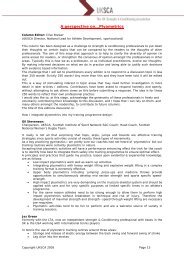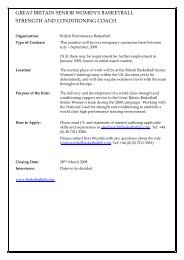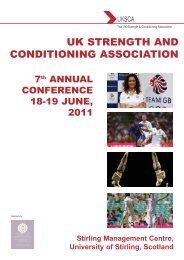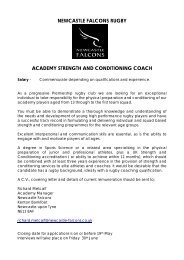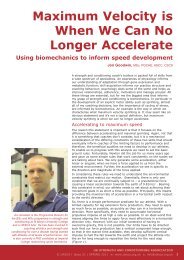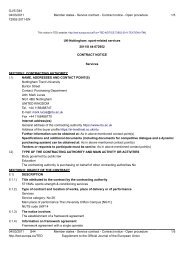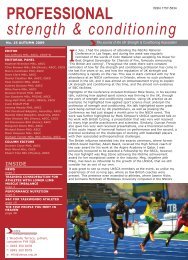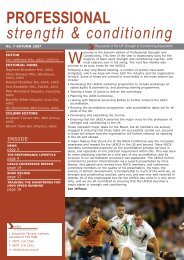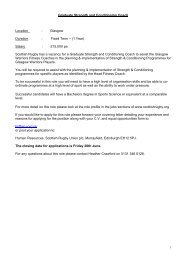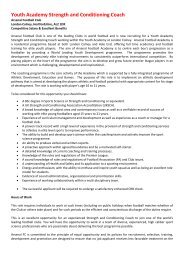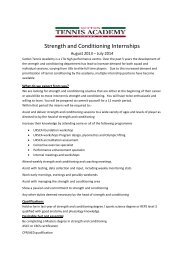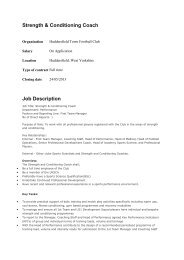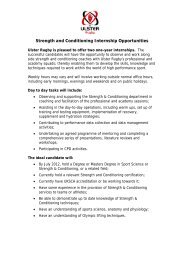uksca news june 2010.qxp
uksca news june 2010.qxp
uksca news june 2010.qxp
Create successful ePaper yourself
Turn your PDF publications into a flip-book with our unique Google optimized e-Paper software.
e noted that it is vital that the level of athlete is<br />
correctly determined before the implementation of this<br />
system, due to the high workload and stresses<br />
associated.<br />
Concurrent training<br />
Concurrent training refers to the training of multiple<br />
training characteristics at any one time during a<br />
training period. This is common in team sports, as they<br />
require multiple training characteristics in order to<br />
perform. 12 Concurrent training is highly common,<br />
especially during the in-season in team sports, when<br />
priority is focused on the sport specific training, with a<br />
greater emphasis on energy systems training. 3<br />
Evidence suggests that energy systems training<br />
negatively contributes to strength levels when<br />
performed together 7,29 potentially due to the conflicting<br />
neural patterns, fibre recruitment, and hormonal<br />
outputs that arise from high volume energy systems<br />
training. 8,14,18 Recent work by Garcia-Pallares and<br />
colleagues 13 demonstrated how an effectively planned<br />
concurrent training programme can elicit improvements<br />
through a system of prioritising fitness components to<br />
sequentially develop in each training phase, and<br />
minimising the interference effect of simultaneous<br />
strength and endurance training. This was achieved by<br />
selecting training objectives that did not interfere with<br />
physiological adaptations at a peripheral level, allowing<br />
for the optimal development of both objectives.<br />
Furthermore, volume and intensity of resistance<br />
training was monitored and controlled with emphasis<br />
placed on order and timing of endurance and<br />
resistance training sessions. 32 It should be considered<br />
that although the training implemented by Garcia-<br />
Pallares and colleagues was concurrent in nature, the<br />
organisation of strength, power and endurance phases<br />
was done using a block model with a consideration of<br />
the interaction between these training characteristics.<br />
It is worth noting that these models are extensions of<br />
the classic model outlined by Matveyev, and that the<br />
main difference is in the application. For example, in all<br />
forms, the annual training plan is constructed and<br />
divided into targeted outcomes based upon the<br />
competitive season. Therefore, during the general<br />
preparatory phase of the training plan, there is to be<br />
an accumulation of training loads, - an accumulation<br />
phase. The length of this phase will vary depending<br />
upon the annual plan, however it will be much longer<br />
during the pre-season when compared with the inseason.<br />
Following this, a specific preparatory phase will<br />
follow, also termed a transmutation phase, where lower<br />
training loads are experienced targeting sport specific<br />
development. This phase is determined by the length<br />
of the general preparatory or accumulation phase, in<br />
order for the delayed training adaptations to take<br />
place. The competitive phase, or realisation phase, is<br />
where training volume is decreased and the quality of<br />
training is increased.<br />
An Approach to Periodisation for<br />
Team Sports<br />
When implementing a periodisation model, the annual<br />
training plan of the sport should first be considered.<br />
From this, long term (macrocycle) plans can be put in<br />
place, to include preparatory, competitive and<br />
transition periods. Further to this, intermediate<br />
(mesocycle) plans can be considered, where more<br />
detail is assembled regarding elements such as the<br />
number and type of stressful competitions, the<br />
requirements for overreaching microcycles, the needs<br />
for transition/ active recovery periods etc. Short term<br />
(microcycle) planning can then take place, to<br />
determine the exact workloads required during<br />
overreaching, maintenance or recovery periods. This<br />
level of planning includes daily training routines, which<br />
take into account active recovery, as well as intra<br />
session recovery. Remembering that the microcycle can<br />
typically be 3-7 days in length and, depending upon<br />
the phase of training, the application of general<br />
preparation, accumulation, specific preparation,<br />
transmutation and competitive/ realisation phases can<br />
be adjusted accordingly.<br />
Before implementing a periodised model, it is worth<br />
noting that rational programme design is only one<br />
element of a restoration plan. Other elements should<br />
include regenerative techniques, nutrition and sleep, 28<br />
which are beyond the scope of this article.<br />
By implementing this model, a systematic strategy to<br />
enhancing performance, whilst also managing fatigue,<br />
can be set up in order to provide the optimal process<br />
for adaptation to take place over the long, intermediate<br />
and short term plans. The key to implementing such a<br />
model is that it takes advantage of the biological<br />
processes of adaptation of the human body allowing<br />
performance enhancement to take place, this process<br />
should be the underlying premise of any training plan.<br />
Therefore, keeping in mind the intense competition<br />
schedule of most team sport athletes, the microcycle<br />
and mesocycle length must be altered to accommodate<br />
for competition. It is likely that this will take place at<br />
least once every calendar week, and over an extended<br />
period of time. The strength and conditioning<br />
practitioner should identify the objectives of each<br />
mesocycle, and determine the systematic sequencing<br />
of training characteristics through each microcycle in<br />
order to create an optimal stimulus for performance<br />
enhancement over a medium to long term plan. From<br />
this, the emphasis of the microcycle can be biased<br />
towards the training characteristics, which are part of<br />
the sport and athlete plan. Although the team sport<br />
athlete has multiple training characteristics to train for,<br />
it is worth noting that when complimentary training<br />
factors are selected and sequenced appropriately,<br />
training outcomes through concurrent training can be<br />
positive. This must be done via the careful<br />
manipulation of the training variables and this should<br />
be based on an understanding of the sequencing of<br />
training characteristics required to optimise<br />
performance factors. Garci-Pallares and colleagues 13<br />
demonstrated the importance of this planning process<br />
through work with elite level kayakers. Here, the<br />
careful planning of training sessions, included the<br />
timing, frequency, volume and intensity of training<br />
stimuli, and also considered the effects of<br />
complimentary strength, power and endurance training<br />
on performance. On a short term (microcycle) level,<br />
daily training should be planned effectively to allow<br />
optimal adaptation from the session objectives.<br />
Considerations include, the acute training stressors, the<br />
frequency of training, recovery periods and potential<br />
interference effects. This should be reproduced in the<br />
medium (mesocycle) to long term plan (macrocycle),<br />
where the sequencing of training characteristics allows<br />
for the development of multiple training characteristics<br />
through a periodised plan over a relatively short length<br />
8<br />
UK STRENGTH AND CONDITIONING ASSOCIATION<br />
© UKSCA | Issue 18 | Summer 2010 w: www.<strong>uksca</strong>.org.uk e: info@<strong>uksca</strong>.org.uk



